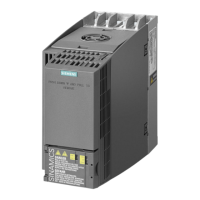Motor Components
5.4 Holding brake
Determining the minimum voltage
The minimum voltage of 24 V DC -10% must be available at the connector on the motor side
in order to guarantee that the brake reliably opens. If the maximum voltage of 24 V DC +10
% is exceeded, then the brake could re-close. The voltage drop along the brake feeder cable
must be taken into consideration.
The voltage drop for copper cables can be approximately calculated as follows:
dU = 0.042 ∙ (l/q) ∙ I
brake
l= cable length in m
q= brake conductor cross-section in mm
2
I
brake
= DC current of the brake in A
dV= voltage drop along the brake cable in V
Example: Calculating the voltage drop for 1FT6084 with EBD 3.5BN brake
I
brake
= 0.9 A, l = 50 m, q = 1 mm
2
dV = 0.042 ∙ 50/1 ∙ 0.9 = 1.89
This means that the voltage, on the supply side, must be a minimum of
24 V ∙ 0.9 + 1.89 V = 23.5 V.
General Section for Synchronous Motors
5-10 Configuration Manual, (PJAL), 11.2005 Edition, 6SN1 197-0AD07-0BP4

